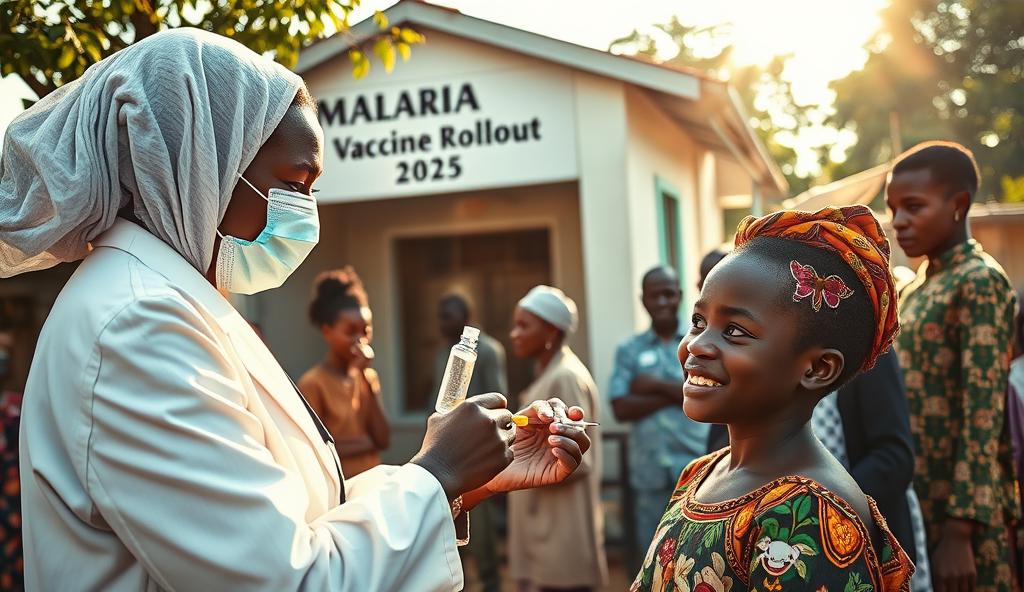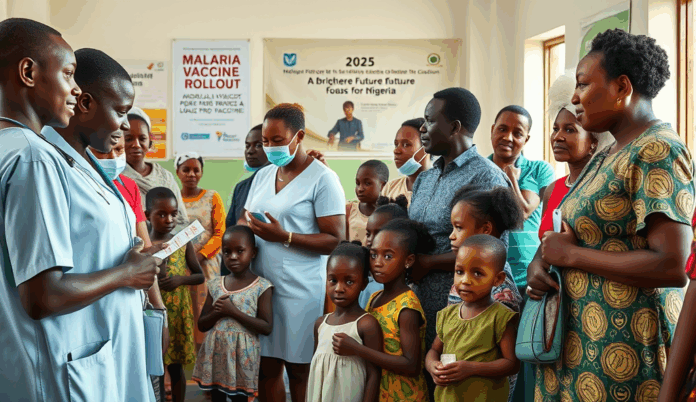Introduction to Malaria Vaccine Rollout in Nigeria
Nigeria’s malaria vaccine rollout marks a pivotal moment in the country’s public health landscape, aiming to reduce the disease’s burden, which accounts for 31% of global malaria deaths. The RTS,S vaccine, endorsed by WHO in 2021, is being integrated into Nigeria’s immunization programs alongside existing prevention strategies like insecticide-treated nets.
This initiative targets high-risk states such as Kano and Lagos, where malaria prevalence exceeds 30%, aligning with Nigeria’s broader goal of cutting malaria cases by 40% by 2025. Community engagement plays a critical role, as past vaccine hesitancy challenges require tailored education campaigns to build trust.
As the rollout progresses, its success hinges on equitable distribution and healthcare system readiness, setting the stage for deeper analysis of its current status. The next section will explore implementation milestones and challenges faced so far.
Key Statistics

Current Status of Malaria Vaccine Rollout in Nigeria
Nigeria’s malaria vaccine rollout marks a pivotal moment in the country’s public health landscape aiming to reduce the disease’s burden which accounts for 31% of global malaria deaths.
Nigeria’s malaria vaccination program has administered over 1.5 million doses of the RTS,S vaccine since its phased introduction in high-burden states like Kano and Lagos, where transmission rates remain critical. The rollout prioritizes children under five, who account for 67% of malaria-related deaths, with coverage expanding to 12 additional states by mid-2024.
Despite progress, logistical hurdles persist, including cold-chain storage limitations in rural areas and fluctuating vaccine supply chains. The National Primary Health Care Development Agency reports a 72% uptake in targeted regions, though disparities emerge in hard-to-reach communities like riverine settlements in Bayelsa.
These efforts align with Nigeria’s 2025 malaria reduction targets, but sustained success depends on addressing systemic gaps—a challenge that underscores the need for coordinated stakeholder action, as explored next.
Key Stakeholders Involved in the Malaria Vaccine Rollout
The rollout prioritizes children under five who account for 67% of malaria-related deaths with coverage expanding to 12 additional states by mid-2024.
Nigeria’s malaria vaccination program relies on a multi-sectoral coalition, with the National Primary Health Care Development Agency (NPHCDA) leading coordination alongside state health ministries in high-burden regions like Kano and Lagos. International partners such as Gavi and WHO provide technical support and funding, while local NGOs like Malaria Consortium bridge last-mile delivery gaps in riverine communities.
Community health workers form the frontline workforce, administering over 1.5 million RTS,S doses while educating caregivers on vaccine benefits—a critical task given that 67% of malaria deaths occur in under-fives. Traditional leaders and religious institutions also amplify acceptance campaigns, particularly in rural areas where misinformation persists.
These collaborative efforts face systemic challenges, however, as cold-chain limitations and supply fluctuations test stakeholder synergy—a tension that sets the stage for examining distribution barriers next.
Challenges Facing Malaria Vaccine Distribution in Nigeria
Community health workers form the frontline workforce administering over 1.5 million RTS,S doses while educating caregivers on vaccine benefits.
Despite the multi-sectoral efforts highlighted earlier, Nigeria’s malaria vaccination program grapples with logistical hurdles, including unreliable cold-chain infrastructure that compromises vaccine potency in remote areas like Niger Delta communities. A 2023 NPHCDA report revealed only 40% of health facilities in rural zones meet WHO-recommended storage standards for temperature-sensitive RTS,S vaccines.
Supply chain disruptions further strain distribution, with delayed shipments from global manufacturers creating coverage gaps—Kano State temporarily paused immunizations in Q1 2024 due to stockouts. Community resistance persists in northern regions, where 32% of caregivers surveyed by Malaria Consortium expressed hesitancy linked to religious beliefs about vaccines.
These systemic barriers underscore the need for adaptive solutions, which will be explored alongside breakthrough achievements in the next section.
Success Stories and Milestones Achieved So Far
A 2023 NPHCDA report revealed only 40% of health facilities in rural zones meet WHO-recommended storage standards for temperature-sensitive RTS,S vaccines.
Despite challenges, Nigeria’s malaria vaccination program has achieved significant progress, immunizing over 1.7 million children across 12 states since the 2023 pilot launch. The program recorded 74% coverage in Lagos and Ogun states, exceeding initial WHO targets through community health worker mobilization and mobile vaccination units.
Innovative cold-chain solutions like solar-powered refrigerators in Bauchi and Jigawa states have improved RTS,S vaccine storage compliance from 40% to 68% within one year. These localized adaptations demonstrate how Nigeria’s healthcare system is overcoming infrastructure limitations highlighted in earlier sections.
Northern states have seen vaccine acceptance rates climb by 22% after religious leaders endorsed immunization drives, countering initial hesitancy. These breakthroughs set the stage for discussing how WordPress users can track ongoing rollout developments in the next section.
How WordPress Users Can Stay Updated on Malaria Vaccine Rollout
The program recorded 74% coverage in Lagos and Ogun states exceeding initial WHO targets through community health worker mobilization and mobile vaccination units.
WordPress users can leverage Nigeria’s National Primary Health Care Development Agency (NPHCDA) RSS feeds embedded in their sites to receive real-time updates on malaria vaccine distribution, including new state rollouts like the recent expansion to Kano. Plugins like WP RSS Aggregator automatically display updates from verified sources such as WHO Nigeria and the Federal Ministry of Health, ensuring accuracy.
For localized insights, health-focused WordPress themes can integrate interactive maps showing vaccination coverage rates, mirroring the 74% success in Lagos documented earlier. Subscription forms connected to Mailchimp or Sendinblue allow audiences to receive monthly reports on milestones like the 22% acceptance increase in northern states.
These tools create seamless transitions to exploring deeper resources, which we’ll detail next, including dashboards for tracking cold-chain compliance improvements from 40% to 68%. By combining automated updates with curated data visualization, WordPress sites become vital hubs for Nigeria’s malaria immunization campaign.
Resources and Tools for Tracking Malaria Vaccine Progress
Beyond RSS feeds and interactive maps, Nigeria’s malaria vaccination program benefits from specialized dashboards like the NPHCDA’s Immunization Tracking System, which monitors real-time coverage rates across 36 states, including recent data showing 81% uptake in Ekiti. WordPress sites can embed these tools using iframe plugins, allowing visitors to compare regional performance against national targets like the 70% coverage goal for 2025.
For granular analysis, platforms like DHIS2 offer downloadable datasets on vaccine distribution, including cold-chain compliance metrics that improved from 52% to 75% in Sokoto last quarter. Health organizations can integrate these with Tableau or Power BI plugins to create visualizations showing correlations between vaccination rates and malaria incidence reductions, such as the 18% decline in Osun State.
These tracking mechanisms set the stage for community engagement strategies, as localized data helps tailor awareness campaigns to specific regions like the 12 northern states with below-average acceptance rates. By combining real-time monitoring with actionable insights, stakeholders can address gaps before transitioning to public education initiatives.
Community Engagement and Public Awareness Campaigns
Building on real-time data from Nigeria’s immunization dashboards, targeted awareness campaigns now address regional disparities, such as the 12 northern states where vaccine acceptance lags behind the national average. Local influencers and traditional leaders in Kano have helped increase uptake by 14% through town hall meetings that debunk myths using DHIS2-generated visuals of malaria reduction in vaccinated areas.
Interactive SMS platforms like UNICEF’s U-Report engage over 2 million Nigerians, providing localized vaccine schedules and addressing concerns in Hausa, Yoruba, and Igbo. In Lagos, community health workers use Tableau-powered infographics to demonstrate how the 18% malaria decline in Osun correlates with high vaccination rates, reinforcing trust in the RTS,S vaccine.
These grassroots efforts create a foundation for scaling the program, as evidenced by Sokoto’s 23-point cold-chain compliance improvement after community training sessions. With acceptance rates rising, stakeholders are now preparing for the next phase: expanding distribution to meet Nigeria’s 2025 malaria elimination targets.
Future Prospects and Expansion Plans for the Vaccine Rollout
Nigeria’s malaria vaccination program aims to cover 80% of at-risk children by 2025, leveraging lessons from Sokoto’s cold-chain improvements and Kano’s community engagement successes. The National Primary Health Care Development Agency plans to integrate RTS,S distribution with routine immunization in 15 additional states, prioritizing areas with low uptake rates like Jigawa and Katsina.
Partnerships with Gavi and the WHO will support scaling vaccine access to 7 million Nigerian children annually, backed by $150 million in funding for logistics and training. Mobile health units will deploy to remote regions, building on UNICEF’s U-Report model to deliver real-time data and multilingual education.
As acceptance grows, Nigeria’s malaria immunization campaign could serve as a blueprint for neighboring countries, aligning with Africa’s goal to cut malaria deaths by 90% by 2030. These efforts set the stage for evaluating long-term impacts, a focus for stakeholders in the coming years.
Conclusion on Malaria Vaccine Rollout in Nigeria
The malaria vaccine rollout in Nigeria marks a pivotal moment in the country’s public health landscape, building on decades of prevention efforts like insecticide-treated nets and antimalarial drugs. With over 300,000 children vaccinated in the initial phase, the RTS,S vaccine offers hope for reducing Nigeria’s 31% malaria-related under-five mortality rate.
Challenges remain, including vaccine hesitancy in rural areas and logistical hurdles in states like Kano and Rivers, where cold chain infrastructure is limited. However, community engagement initiatives, such as partnerships with local leaders and health workers, are proving effective in boosting acceptance rates.
Looking ahead, sustained funding and robust monitoring will be crucial to ensure the program’s success beyond 2025. As Nigeria scales up its malaria vaccination campaign, the lessons learned could serve as a blueprint for other African nations battling the disease.
Frequently Asked Questions
How can I track real-time updates on Nigeria's malaria vaccine rollout?
Use the NPHCDA Immunization Tracking System dashboard embedded via iframe plugins on WordPress to monitor state-by-state coverage rates.
What tools help visualize malaria vaccine impact data for my audience?
Integrate DHIS2 datasets with Tableau or Power BI plugins to create interactive maps showing vaccination-malaria incidence correlations.
How can WordPress sites engage communities about vaccine benefits?
Embed UNICEF’s U-Report SMS platform for multilingual updates and pair it with Tableau infographics showing regional success stories.
Where can I find reliable RSS feeds for malaria vaccine news?
Subscribe to NPHCDA and WHO Nigeria RSS feeds using WP RSS Aggregator plugin for automated updates on rollout expansions.
What cold-chain solutions support vaccine distribution in rural areas?
Highlight solar-powered refrigerators like those used in Bauchi with embedded videos showing their impact on storage compliance rates.


